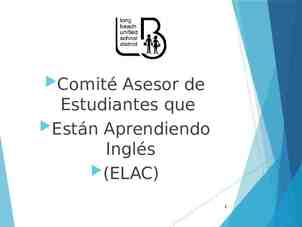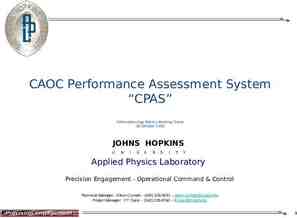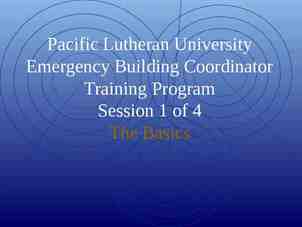D H S A G I N G S E RV I C E S TITLE III POLICIES AND
21 Slides87.71 KB

D H S A G I N G S E RV I C E S TITLE III POLICIES AND PROCEDURES MANUAL EMPLOYEE TRAINING MODULE SEPTEMBER ( U P D AT E D 1 0 - 6 - 2 0 1 6 )

THE MANY FACES OF AGING IN AMERICA (DOUBLE CLICK TO START VIDEO)

DHS POLICIES Current DHS policies are broken down into 16 sub categories with procedures included. 1. Designations of Area Agencies on Aging 2. Responsibilities of Area Agencies on Aging 3. Area Agency on Aging Advisory Council 4. Area Plan on Aging 5. Amendments to the Area Plan 6. Area Plan Management Plan 7. Area Plan Administration

16 CONTINUED 8. Coordination and Resource Development 9. Targeting Resources to Older Persons 10. Advocacy 11. Funding Local Sponsors for the Provisions of Direct Services 12. Title III Direct Service Waivers 13. Designation of Community Focal Points 14. Monitoring and Evaluations of Title III Projects 15. Provision of Technical Assistance and Training 16. Area Agency on Aging Disaster Planning

D E S I G N AT I O N O F A R E A A G E N C I E S O N AG I N G 340:105-10-30. Designation of Area Agencies on Aging Revised 5-13-02 (a) Policy. An entity applying for designation as an Area Agency on Aging (AAA) must be an agency whose single purpose is to administer programs for older persons or a separate organizational unit within a multipurpose agency which functions only for purposes of serving as the AAA. Once designated, the AAA is responsible for providing adequate and qualified staff to perform all functions of the AAA. A designated AAA continues to function in that capacity until the AAA informs the State Agency that it no longer wishes to carry out the responsibilities of an AAA, or until the State Agency withdraws the designation of the AAA as provided for in OAC 340:105-10-21. (b) Authority. The authority for this Section is Title 45 of the Code of Federal Regulations, Part 1321.55. (c) Procedures. To apply for designation as an AAA, an entity described in (a) of this Section must respond in the State Agency prescribed Area Plan format as provided in OAC 340:105-10-33 to the Local Funding Contract Announcement published annually in the Oklahoma Register. Application packets and technical assistance may be obtained from Aging Services Division, Department of Human Services at P. O. Box 25352, Oklahoma City, OK 73125, (405) 521-2281. (d) Cross references. See OAC 340:105-10-20, 340:105-10-21, 340:105-10-31 and 340:105-10-33 .

RESPONSIBILITIES OF AREA AGENCIES ON AGING 340:105-10-31. Responsibilities of area agencies on aging Revised 6-1-07 (a) Policy. Area agencies on aging (AAAs) are responsible for activities related to the development or enhancement of comprehensive and coordinated community-based systems of services in the planning and service areas (PSAs), including: (1) establishing and maintaining an AAA advisory council; (2) developing an Area Plan on Aging as prescribed by the State Agency on Aging; (3) administering the Area Plan on Aging; (4) coordinating all area activities related to the purposes of the Older Americans Act, and actively pursuing resource development at the local and area levels; (5) targeting resources to older persons in greatest social and economic need; (6) developing, coordinating, and administering an Emergency Preparedness Plan; (7) serving as a visible and effective advocate for older persons in the PSA; (8) granting funding to local sponsors for the provision of direct Title III services; (9) designating one or more focal points on aging in each community for the maximum collocation and coordination of services for older persons; (10) monitoring and evaluating the local service projects; and (11) providing technical assistance and training to Title III project staff related to responsibilities under Title III of the Older Americans Act. (b) Authority. The authority for this Section is Sections 1321.53 and 1321.61 of Title 45 of the Code of Federal Regulations. (c) Procedures. Procedures are outlined separately in this Part for each area of responsibility identified in (a) of this Section. (d) Cross references. See OAC 340:105-10-33 through 340:105-10-45.

AREA AGENCIES ON AGING ADVISORY COUNCIL 340:105-10-32. Area Agency on Aging advisory council Revised 6-1-08 (a) Policy. Each Area Agency on Aging (AAA) establishes and maintains an advisory council. The council carries out advisory functions which further the AAA's mission of developing and coordinating community-based systems of services for all older persons in the planning and service area. (1) The advisory council is separate and distinct from the AAA governing board and composed of: – (A) more than 50 percent older persons, including minority persons who are participants or who are eligible to participate in Title III programs, and family caregivers of such persons; – (B) representatives of older persons; – (C) representatives of health care provider organizations, including providers of veterans' health care, if appropriate; – (D) representatives of supportive services providers; – (E) persons with leadership experience in the private and voluntary sectors; – (F) local elected officials; and – (G) the general public. (2) The advisory council may not be composed of: – (A) State Agency staff or governing board members; – (B) AAA staff or governing board members; – (C) Title III project staff or governing board members; or – (D) any other persons that may give an appearance of a potential conflict of interest.

AREA PLAN ON AGING 340:105-10-33. Area Plan on Aging Revised 6-1-07 (a) Policy. In order to receive or continue Area Agency on Aging (AAA) designation, the applicant agency must develop an Area Plan for a two, three, or four year period as determined by the State Agency, with annual adjustments as may be necessary. The format for the Area Plan is predetermined by the State Agency and includes, at a minimum: (1) a mission statement of the AAA; (2) an overview of the Older Americans Act (OAA) and the aging network; (3) a listing of the AAA advisory council members and their responsibilities; (4) a summary of the needs and priorities of older persons in the planning and service area (PSA) and in each respective county within the PSA; (5) goals and measurable objectives that reflect the identified needs and priorities of older persons in the PSA and comply with state and federal mandates; (6) a financial management plan; (7) a description of emergency preparedness efforts in the PSA; (8) a listing of all designated focal points in the PSA; (9) all provisions and assurances required by the OAA, related regulations, and State Agency policy; and (10) a summary of the public hearing conducted on the proposed Area Plan.

AMENDMENTS TO THE AREA PLAN 340:105-10-34. Amendments to the Area Plan Revised 5-13-02 (a) Policy. An Area Agency on Aging (AAA) amends its Area Plan when circumstances include: (1) a new or amended state or federal statute or regulation requiring a new provision or conflicting with any existing plan provisions; (2) a United States Supreme Court decision changing the interpretation of a statute or regulation; (3) the AAA proposing to add, substantially modify, or delete any Area Plan objective(s); (4) the AAA proposing to substantially modify its budget; (5) new or amended State Agency policy requiring a new provision or conflicting with any existing plan provisions; or (6) annually revising information required by Section 307(a) of the Older Americans Act, as amended. (b) Authority. The authority for this Section is Title 45 of the Code of Federal Regulations, Parts 1321.11 and 1321.59. (c) Procedures. Proposed amendments to the Area Plan must be documented on those Area Plan exhibits affected by the revision(s) and submitted with written rationale to the State Agency for approval. All Area Plan amendments must be subject to review and comment in accordance with the public hearing procedure outlined in OAC 340:105-10-33, except in cases where the State Agency requires technical revisions, or an objective is modified or deleted because it cannot be attained due to factors beyond the control of the AAA. The State Agency may waive the public hearing requirement only after considering the public interest relative to the amendment. All Area Plan amendments, including annual updates, must follow procedures outlined in OAC 340:105-10-33. The AAA follows additional State Agency guidance, as provided, regarding annual Area Plan updates. (d) Cross references. See OAC 340:105-10-33, 340:105-10-35, and 340:105-10-36.

AREA PL AN MANAGEMENT PLAN 340:105-10-35. Area Plan Management Plan Issued 11-29-93 (a) Policy. The Area Agency will develop an annual Management Plan to outline the actions necessary to accomplish the Area Plan goals and objectives. A format for the Management Plan shall be provided by the State Agency. (b) Authority. The authority for 340:105-10-35 is 45 CFR Part 1321.11. (c) Procedures. The Area Agency will consider each of its Area Plan objectives and will outline the specific actions necessary to complete them on a format provided or approved by the State Agency. The Area Agency must submit its completed Management Plan to the State Agency for review at least six weeks prior to its effective date. The Area Agency will include the following in the Management Plan: (1) Area Plan goals and objectives; (2) Specific action steps planned to carry out each objective; (3) Target dates for the completion of each action step; and (4) Staff person(s) responsible for accomplishing each action step. (d) Cross references. See OAC 340:105-10-33, 340:105-10-34, and 340:105-10-36.

A R E A P L A N A D M I N I S T R AT I O N 340:105-10-36. Area Plan administration Revised 6-1-08 (a) Policy. The Area Agency on Aging (AAA) has responsibility for carrying out all activities under the Area Plan on Aging. (b) Authority. The authority for this Section is Section 306 and Section 212(b)(1) of the Older Americans Act, as amended, and Parts 1321.61 and 1321.53 of Title 45 of the Code of Federal Regulations. (c) Procedures. The AAA: (1) develops and monitors a management plan for the Area Plan on Aging which includes: – (A) overall plan goals; – (B) measurable objectives which outline what will be done to reach the goal; – (C) action steps that describe how each objective will be accomplished, such as specific tasks; – (D) staff assignments of responsibility for each objective; and – (E) target dates for the completion of action steps; (2) submits all required program and fiscal reports related to Area Plan activities to the State Agency; (3) develops a Title III request for proposal (RFP) package and provide technical assistance on the applications to prospective grantees; (4) reviews and approves Title III RFPs, except for-profit applications that must be reviewed and approved by the State Agency; (5) monitors the program and fiscal reports of Title III projects in the planning and service area (PSA); (6) conducts on-site quarterly assessments with each Title III project and forwards follow-up written reports to each project; (7) provides technical assistance to the Title III projects as appropriate; and (8) develops a policy and procedures manual for Title III projects in the PSA. (d) Cross references. See OAC 340:105-10-31(a)(3), 340:105-10-33, and 340:105-10-34.

C O O R D I N AT I O N A N D R E S O U RC E D E V E LO P M E N T 340:105-10-37. Coordination and resource development Revised 6-1-08 (a) Policy. The Area Agency on Aging (AAA) performs activities which maximize the availability of all services to older persons in the planning and service area (PSA), and reduce duplication of effort. Particular effort is made to coordinate with: (1) organizations providing child care services for children, assistance to older persons caring for relatives who are children, and respite for families to provide opportunities for older persons to aid or assist on a voluntary basis; (2) organizations established for the benefit of victims of Alzheimer's disease; (3) the State Agency and the Oklahoma Department of Mental Health and Substance Abuse Services to: – (A) increase public awareness of mental health disorders; – (B) remove barriers to diagnosis and treatment; and – (C) coordinate mental health services, including mental health screenings, provided with funds expended by the AAA with mental health services provided by community health centers and by other public agencies and nonprofit private organizations; (4) job training and partnership programs; (5) Title II programs of the Domestic Volunteer Service Act of 1973; (6) Titles XVI, XVIII, XIX, and XX programs of the Social Security Act; (7) federal housing programs, United States Housing Act of 1937 or Section 202 of the Housing Act of 1959; (8) Title I programs of the Housing and Community Development Act of 1974; (9) adult education programs, Title I of the Higher Education Act of 1965 or Adult Education Act; (10) transportation programs, Section 5310 of the Transportation Equity Act; (11) public health programs, Title XIX of the Public Health Service Act; (12) energy assistance programs, Low-Income Home Energy Assistance Act of 1981; (13) weatherization assistance for low income persons, Part A of the Energy Conservation in Existing Buildings Act of 1976; (14) programs funded by the Community Services Block Grant Act; and (15) trained volunteers providing direct services to older persons and persons with disabilities working when possible with organizations that have experience in providing training, placement, and stipends for volunteers or participants in community services settings such as organizations carrying out federal service programs administered by the Corporation for National and Community Service.

TA R G E T I N G R E S O U R C E S T O O L D E R P E R S O N S 340:105-10-38. Targeting resources to older persons in greatest economic or social need Revised 6-1-08 (a) Policy. The Area Agency on Aging (AAA) takes a leadership role in assisting communities throughout the planning and service area (PSA) to target resources from all appropriate sources to meet the needs of older persons with greatest economic or social need, with particular attention to low income minority individuals. In addition to low income minority older persons, the groups of older persons targeted for special consideration under this Section include older: (1) persons residing in rural or isolated areas; (2) persons with severe disabilities; (3) persons with limited English proficiency; (4) persons at risk for institutional placement; (5) persons with Alzheimer's disease and related disorders with neurological and organic brain dysfunction and the caretakers of such persons; and (6) Native Americans.

ADVOCACY 340:105-10-39. Advocacy Revised 5-13-02 (a) Policy. The Area Agency on Aging (AAA) serves as the public advocate for the development or enhancement of comprehensive and coordinated community-based systems of services in each community throughout the planning and service area (PSA). (b) Authority. The authority for this Section is Title 45 of the Code of Federal Regulations, Part 1321.61, and Section 306(a)(6)(B) of the Older Americans Act of 1965, as amended. (c) Procedures. In carrying out its advocacy responsibility, the AAA: (1) monitors, evaluates, and, when appropriate, comments on all policies, programs, hearings, levies, and community actions which affect older persons in the PSA; (2) solicits comments from the public on the needs of older persons; (3) represents the interests of older persons to local level and executive branch officials, public and private agencies or organizations; (4) consults with and supports the state's Long-Term Ombudsman Program; and (5) undertakes on a regular basis, activities designed to facilitate the coordination of plans and activities with all other public and private organizations, including units of general purpose local government, with responsibilities affecting older persons in the PSA to promote new or expanded benefits and opportunities for older persons. (d) Cross references. See OAC 340:105-10-31(a)(6).

F U N D I N G LO C A L S P O N S O R S F O R T H E P R OV I S I O N S O F D I R E C T S E RV I C E S 340:105-10-40. Funding local sponsors for the provision of direct Title III services Revised 6-1-08 (a) Policy. The Area Agency on Aging (AAA) awards all Title III of the Older Americans Act (OAA) of 1965 service funds by grant or contract to community services provider agencies and organizations, except where a direct service waiver(s) has been granted by the State Agency, per OAC 340:105-10-41, for the purpose of developing or enhancing a comprehensive and coordinated community-based system of services for older persons in the planning and service area (PSA). OAC340:105-10-50.1 lists the services that may be funded under Title III. (b) Authority. The authority for this Section is Section 306(a) and Section 212(b)(1) of the OAA of 1965, as amended, and Section 1321.63 (b) of Title 45 of the Code of Federal Regulations. (c) Procedures. The AAA staff, advisory council, and board of directors follow the procedures in this Section prior to awarding Title III funds. (1) AAA staff: – (A) conducts a needs assessment and identifies priority needs in the PSA; – (B) evaluates the current service system and identifies any gaps in the system; – (C) establishes a funding formula that describes the systematic procedure the AAA follows in allocating funds for services within the PSA, per OAC 340:105-10-100; – (D) develops the request for proposal (RFP) packages for all Title III services to be funded, per OAC 340:105-10-101; – (E) publicly announces the RFP and distributes RFP packages to potential grantees; – (F) reviews proposals for required documents and provides feedback and technical assistance, as appropriate, to potential grantees; and – (G) rates each proposal using approved review criteria. (2) AAA advisory council evaluates and rates all proposals. (3) AAA board of directors, or a subcommittee: – (A) reviews and evaluates all proposals, except for-profit applications that must be reviewed and approved by the State Agency; and – (B) considers the ratings of the AAA staff and advisory council, and the review findings of the board of directors, and awards funds for the proposals that best meet RFP specifications. (d) Cross references. See OAC 340:105-10-31(a)(7), 340:105-10-41, 340:105-10-50.1, 340:105-10-100, and 340:105-10-101.

T I T L E I I I D I R E C T S E RV I C E WA I V E R S 340:105-10-41. Title III direct services waivers Revised 7-15-06 (a) Policy. Provisions under the Older Americans Act (OAA), including subsequent amendments, specify which Title III direct services are authorized or prohibited under the law. Direct services otherwise prohibited by OAA may be permitted by the State Agency if, in the judgment of the State Agency, provision of the services is: (1) necessary to ensure an adequate supply of the services; (2) related to the administrative functions of the Area Agency on Aging (AAA); or (3) more economical and of comparable quality. 1 (b) Authority. The authority for this Section is Section 307(a)(8) of the OAA of 1965, as amended.

D E S I G N AT I O N O F C O M M U N I T Y F O C A L P O I N T S 340:105-10-42. Designation of community focal points Issued 11-29-93 (a) Policy. The Area Agency shall designate, where feasible, a focal point for comprehensive service delivery in each community in the planning and service area, giving special consideration to designating multipurpose senior centers as such focal points. These focal points shall be established to encourage the maximum collocation and coordination of services for older persons. The Area Agency must undertake all necessary efforts to assure that services financed under the Older Americans Act, as amended, in, or on behalf of, each community will be either based at, linked to or coordinated with the designated focal point. (b) Authority. The authority for OAC 340:105-10-42 is Section 306(a)(3) of the Older Americans Act, as amended, and 45 CFR Part 1321.53(c). (c) Procedures. The Area Agency will designate and implement community focal points by carrying out the following activities:

M O N I T O R I N G A N D E VA L U AT I O N S O F T I T L E I I I P R O J E C T S 340:105-10-43. Monitoring and evaluation of Title III projects Revised 8-15-04 (a) Policy. The Area Agency on Aging (AAA) monitors and evaluates all funded Title III projects to ensure services are provided in accordance with federal and state policy and objectives of the service grant or contract are met. (b) Authority. The authority for OAC 340:105-10-43 is Part 1321.65 and Section 1321.53(a) of Title 45 of the Code of Federal Regulations. (c) Procedures. Except on specific projects where the State Agency has agreed with the AAA to provide a service, the AAA fulfills its responsibility to monitor and evaluate Title III projects by carrying out the activities described in this subsection. The AAA: (1) develops a policy and procedures manual for Title III projects that includes all federal and state mandates; (2) monitors the program and fiscal reports of Title III projects; (3) conducts quarterly on-site program assessments with each Title III project that include evaluation of the extent to which: – (A) the proposed service output, as outlined in the project grant or contract, is met, such as numbers of persons served, units of each service provided, and expenditures by source and service; – (B) each objective, and related action steps, are completed by the targeted dates as indicated in the grant or contract; – (C) provider responsibilities regarding general Title III service standards, outlined in OAC 340:105-10-51, are met; – (D) service specific standards are being met; and – (E) federal, state, and local laws and regulations, such as Civil Rights Act and Americans with Disabilities Act, are followed;

P R O V I S I O N O F T E C H N I C A L A S S I S TA N C E A N D T R A I N I N G 340:105-10-44. Provision of technical assistance and training to Title III projects Revised 5-13-02 (a) Policy. The Area Agency on Aging (AAA) provides technical assistance and training to Title III projects related to all aspects of the project's responsibilities as Title III grantees. As funding permits, the AAA enters into grants and contracts with providers of education and training services that can demonstrate the capacity to provide such services. (b) Authority. The authority for this Section is Title 45 of the Code of the Federal Regulations, Part 1321.53 and Section 306 of the Older Americans Act (OAA) of 1965, as amended. (c) Procedures. The AAA carries out its responsibility to provide technical assistance and training by: (1) providing and arranging for orientation of each Title III staff person on: – (A) the OAA and related regulations; – (B) the State of Oklahoma Title III Policies and Procedures Manual, including general Title III service standards, OAC 340:105-10-51, and service specific standards; – (C) AAA Title III policy and procedures manual; – (D) all program and fiscal reports, as appropriate; – (E) assessment procedures; and – (F) the aging network; (2) providing ongoing telephone, written, and on-site technical assistance to the projects, as needed and as requested; and (3) developing and implementing training objectives for Title III projects staff, and providing annual updates, as appropriate. (d) Cross references. See OAC 340:105-10-31(a)(10) and 340:105-10-51.

AREA AGENCY ON AGING DISASTER PL ANNING 340:105-10-45. Area agency on aging disaster planning Revised 6-1-07 (a) Policy. The area agency on aging (AAA) makes arrangements for the availability of services to older persons, where feasible and appropriate, in weather related emergencies and other disasters, including local and national emergencies, such as terrorist acts and flu pandemics. (b) Authority. The authority for this Section is Section 1321.65(e) of Title 45 of the Code of Federal Regulations. Please visit DHS for a complete listing of ALL of these policies and procedures.

SOURCES http://www.okdhs.org/sites/searchcenter/Pages/okdhspolicy https://youtu.be/8Gms2ogdLVE






